
This is a blog about the Beechwood Wetland area in Toronto and my involvement with it. Last week I went to a meeting of the Community Stewardship Program, a city-sponsored initiative which recruits volunteers to work at various sites around the city. Teams monitor the flora and fauna, improve/restore habitat, remove litter and invasive weeds and plant appropriate native vegetation. I can do that! I get a lot of good out of exploring along the Don River and I'd like to give something back.
After hearing about all the options I signed up to work at the Beechwood Wetland site. It's close to my house, so I can walk there easily -- a big bonus. Our team will meet on-site for the first time this evening to get things started. I've been checking out the site over the past week to familiarize myself with some of the plants -- don't want to pull up the wrong thing!
I must acknowledge the effort and dedication of the Task Force to Bring Back the Don and the city's Parks and Rec department, as well as many other volunteers, who got this project underway. Check out the links in the sidebar for info and pictures about the early days of this wetland site. It's come a long way in a short time thanks to everyone's hard work.
The good: come and enjoy nature without having to leave the city! There's lots of wildlife and vegetation. Over the last few days I've seen a raccoon (okay, they hang out on my balcony too, so not a big thrill), a muskrat and some rabbits, including this baby who sat perfectly still so I wouldn't see him. Good work, bunny, I can hardly see you at all!

It's also a good spot for birdwatching. I've seen more orioles in the past week than I have in all the rest of my life. (Although I have yet to get a good picture. Take my word for it, they're very pretty -- bright orange with black heads -- and they sing sweetly.) Another bird I haven't captured with my camera yet is the black-crowned night heron. There was one flapping along the river last night. I've also noted woodpeckers, song sparrows, loads of red-winged blackbirds, and the more common birds such as robins, starlings and house sparrows.
There's a great variety of wildflowers, and I'm trying to learn more of their names. This beautiful creature is birdsfoot trefoil:

It's also a good place for insect-watching, although I have even more trouble with these than with the plants. Anybody know what kind of caterpillar this is?

The bad: there is a heck of a lot of dog-strangling vine and Japanese knotweed in the valley. These are invasives that threaten to crowd out the native plants, and they're doing a good job so far. I don't think we'll ever win this war, but we can aim for little oases of natural habitat.
These are the flowers of the dog-strangling vine:
Pretty enough, no? Don't be fooled, though, this is the enemy. Here's a little patch of it so you can get an idea of how it takes over: It will grow at an alarming rate and twine itself around trees, eventually bringing them down, or choking them to death, or hogging all their food, or stealing their credit cards, or something. Whatever it does, it's bad. This picture was taken on the opposite side of the river, a bit farther north, but it could happen anywhere.
It will grow at an alarming rate and twine itself around trees, eventually bringing them down, or choking them to death, or hogging all their food, or stealing their credit cards, or something. Whatever it does, it's bad. This picture was taken on the opposite side of the river, a bit farther north, but it could happen anywhere.

Another evil-doer is Japanese knotweed, which also grows rapidly and crowds out everything else. Here it is looking small and innocent enough, but pretty soon it will be turning itself into a bamboo-like forest.


No comments:
Post a Comment